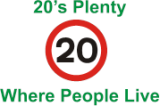From the 20’s Plenty Campaign
Slowing speed limits from 30 mph to 20 mph contributes to increasing the attractiveness of cycling and walking relative to other options. 20 mph increases physical activity and reduces traffic.
With the exceptions of road closures and congestion charging, it is hard to prove that any single traffic intervention results in raising active travel. A choice to walk or cycle is complex, involving factors like distance, route knowledge, safe routes, weather, topography and cycle parking. Yet, it is well researched that traffic speeds are a major barrier to choosing to walk or cycle. Perception of risk is strongly involved in the “how shall I get there?” decision.
Volumes and speeds of traffic are inversely correlated to walking and cycling levels – when one side of the equation rises, the other falls. Interventions that reduce traffic speed and volume are likely to promote walking and cycling and thus result in public health gains.[i] This is compounded by critical mass effects. Where there are more cyclists or walkers, safety increases due to its visibility and popularity, making drivers more conscious of vulnerable road users.
The key prerequisite for sustainable travel is creating the conditions in which walking and cycling are more attractive than car use. Reviews have found methods that pull people toward active travel include increasing the percentage of the local road network where speeds are limited e.g. to 20 mph (30 km/h)[ii] Unsurprisingly, in Europe 30km/h speed limits are the foundation of cycling and walking policies in Denmark, Belgium, Germany, Netherlands, Norway and Sweden.
In Portsmouth, which implemented 20 mph limits on 94% of its roads in 2008, “over 40% of respondents stated that since the introduction of the scheme, there has been a safer environment for walking and cycling; and as a result, around a third of respondents felt that there had been an increase in pedestrian and cyclist activities in the local areas.”[iii]
Health professionals see lower traffic speeds as a foundation for increasing “active travel” leading to a healthier nation. The Association of Directors of Public Health with the National Heart Forum have developed a “position statement” on the benefits of 20mph as the default limit for residential and urban areas.[iv]
It is time to give people a real choice in how they travel by removing the fear of fast traffic from community streets. The authorities of over 6 million people have committed to do so.
More information at www.20splentyforus.org.uk
________________________________________
[i] Jacobsen,PL; Racioppi,F; Rutter,H (2009) Who owns the roads? How motorised traffic discourages walking and bicycling, Injury Prevention, v15, pp369-373.
[ii] Oja,P; Vuori,I (2000) PROMOTION OF TRANSPORT WALKING AND CYCLING IN EUROPE: Strategy Directions, The European Network for Promotion of Health-Enhancing Physical Activity. http://www.panh.ch/hepaeurope/materials/HEPA%20Walking%20and%20Cycling%20Strategy%20.pdf
[iii] http://www2.dft.gov.uk/pgr/roadsafety/speedmanagement/20mphPortsmouth/
[iv] http://www.adph.org.uk/files/ourwork/policies/NHF_PositionStatement20mph_2010.pdf

